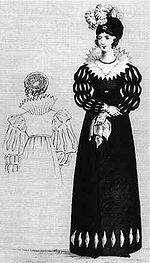
Altdeutsche Tracht
Encyclopedia

Germany
Germany , officially the Federal Republic of Germany , is a federal parliamentary republic in Europe. The country consists of 16 states while the capital and largest city is Berlin. Germany covers an area of 357,021 km2 and has a largely temperate seasonal climate...
between 1813 and 1815, during the time of what is in German historiography known as the Befreiungskriege, the "liberation wars", the last years of the Napoleonic Wars
Napoleonic Wars
The Napoleonic Wars were a series of wars declared against Napoleon's French Empire by opposing coalitions that ran from 1803 to 1815. As a continuation of the wars sparked by the French Revolution of 1789, they revolutionised European armies and played out on an unprecedented scale, mainly due to...
. It was an expression of anti-French
France
The French Republic , The French Republic , The French Republic , (commonly known as France , is a unitary semi-presidential republic in Western Europe with several overseas territories and islands located on other continents and in the Indian, Pacific, and Atlantic oceans. Metropolitan France...
German national sentiment and met with great approval among women and men of various social strata. The new fashion was intended as a demonstration of resistance against the "French fashion foolishness", as it was described.
It is said that the Austrian officer Count von Sztáray complained already in 1800 to the University of Heidelberg that he saw students dressing according to the fashion of the French enemy:
- It cannot escape the notice of any right-thinking man, how conspicuously many young gentlemen of this University model themselves according to the pattern of the latest thing coughed up by the worst class of French people in costume, moral behaviour, gestures and public decency, to the disgrace of the upright of the German nation.

Ernst Moritz Arndt
Ernst Moritz Arndt was a German nationalistic and antisemitic author and poet. Early in his life, he fought for the abolition of serfdom, later against Napoleonic dominance over Germany, and had to flee to Sweden for some time due to his anti-French positions...
and Karoline Pichler
Karoline Pichler
Karoline Pichler, also spelled Caroline Pichler, was an Austrian novelist. She was born in Vienna to Hofrat Franz Sales von Greiner and his wife Charlotte, née Hieronimus ....
. This new fashion was considered a sign of resistance against the rule of foreigners, but also against the old type of monarchical rule, and of a liberal, democratic disposition. After the foundation of the Urburschenschaft
Urburschenschaft
The Urburschenschaft was the first Burschenschaft, a special type of German Studentenverbindung . Burschenschaften were founded in the early 19th century as associations of university students inspired by liberal and nationalistic ideas.It was founded in 1815 in Jena, Thuringia, in Germany...
in Jena in 1815, it became a sign of belonging to the student Burschenschaft
Burschenschaft
German Burschenschaften are a special type of Studentenverbindungen . Burschenschaften were founded in the 19th century as associations of university students inspired by liberal and nationalistic ideas.-History:-Beginnings 1815–c...
en, who wanted to stand out from the traditionally minded, regionally oriented corps
German Student Corps
Corps are the oldest still-existing kind of Studentenverbindung, Germany's traditional university corporations; their roots date back to the 15th century. The oldest corps still existing today was founded in 1789...
students.
The most prominent bearer of this fashion was the Bavarian Crown Prince Ludwig, the later King Ludwig I
Ludwig I of Bavaria
Ludwig I was a German king of Bavaria from 1825 until the 1848 revolutions in the German states.-Crown prince:...
.

Protestant Reformation
The Protestant Reformation was a 16th-century split within Western Christianity initiated by Martin Luther, John Calvin and other early Protestants. The efforts of the self-described "reformers", who objected to the doctrines, rituals and ecclesiastical structure of the Roman Catholic Church, led...
and Martin Luther
Martin Luther
Martin Luther was a German priest, professor of theology and iconic figure of the Protestant Reformation. He strongly disputed the claim that freedom from God's punishment for sin could be purchased with money. He confronted indulgence salesman Johann Tetzel with his Ninety-Five Theses in 1517...
, which were seen as characteristically German. In the female form, the historical elements added to the fashion included slashed and puffed sleeves, and ruffled collars. The most important piece of clothing for men was a long tight-fitting coat that was often worn with a widely opened collar. To this came widely cut trousers and often a large velvet beret
Beret
A beret is a soft, round, flat-crowned hat, designated a "cap", usually of woven, hand-knitted wool, crocheted cotton, or wool felt, or acrylic fiber....
. The dominant colour was black, the colour of the uniforms of many Freikorps
Freikorps
Freikorps are German volunteer military or paramilitary units. The term was originally applied to voluntary armies formed in German lands from the middle of the 18th century onwards. Between World War I and World War II the term was also used for the paramilitary organizations that arose during...
during the liberation war. In particular among the young men, a rebellious behaviour and unkempt hair and beards were also common.
The fashion was seen as provocative and rebellious enough to be partly prohibited by the authorities during the persecution of "demagogues" (see also Carlsbad Decrees
Carlsbad Decrees
The Carlsbad Decrees were a set of reactionary restrictions introduced in the states of the German Confederation by resolution of the Bundesversammlung on 20 September 1819 after a conference held in the spa town of Carlsbad, Bohemia...
).

